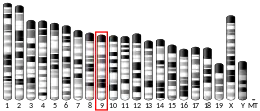C11orf53
Chromosome 11 open reading frame 53 is a protein that in humans is encoded by the C11orf53 gene.[5] Reduction in C11orf53 gene expression is associated with increased odds of occurrence of colorectal cancer.[6] Specifically sequence variation (rs3802842) close to the C11orf53 gene locus that lowers the expression of C11orf53 has been observed in the colonic mucosal cells immediately adjacent to colon cancer tumors.[7][8] C11orf53 downregulation aids in cells' ability to survive in acidic conditions, which are typical of the tumor microenvironment.[9] CRISPR-Cas9 inactivation of C11orf53 in an acute myeloid leukemia cell line made the cells resistant to the BCL2 inhibitor Venetoclax, further supporting a role in cancer predisposition.[10][11]
| POU2AF2 | |||||||||||||||||||||||||||||||||||||||||||||||||||
|---|---|---|---|---|---|---|---|---|---|---|---|---|---|---|---|---|---|---|---|---|---|---|---|---|---|---|---|---|---|---|---|---|---|---|---|---|---|---|---|---|---|---|---|---|---|---|---|---|---|---|---|
| Identifiers | |||||||||||||||||||||||||||||||||||||||||||||||||||
| Aliases | POU2AF2, chromosome 11 open reading frame 53, POU class 2 homeobox associating factor 2, C11orf53 | ||||||||||||||||||||||||||||||||||||||||||||||||||
| External IDs | MGI: 1917059 HomoloGene: 18881 GeneCards: POU2AF2 | ||||||||||||||||||||||||||||||||||||||||||||||||||
| |||||||||||||||||||||||||||||||||||||||||||||||||||
| |||||||||||||||||||||||||||||||||||||||||||||||||||
| |||||||||||||||||||||||||||||||||||||||||||||||||||
| |||||||||||||||||||||||||||||||||||||||||||||||||||
| Wikidata | |||||||||||||||||||||||||||||||||||||||||||||||||||
| |||||||||||||||||||||||||||||||||||||||||||||||||||
References
- GRCh38: Ensembl release 89: ENSG00000150750 - Ensembl, May 2017
- GRCm38: Ensembl release 89: ENSMUSG00000036027 - Ensembl, May 2017
- "Human PubMed Reference:". National Center for Biotechnology Information, U.S. National Library of Medicine.
- "Mouse PubMed Reference:". National Center for Biotechnology Information, U.S. National Library of Medicine.
- "C11orf53 chromosome 11 open reading frame 53 [Homo sapiens (human)] - Gene - NCBI". www.ncbi.nlm.nih.gov.
- Delgado AP, Brandao P, Chapado MJ, Hamid S, Narayanan R (July 2014). "Open reading frames associated with cancer in the dark matter of the human genome". Cancer Genomics & Proteomics. 11 (4): 201–213. PMID 25048349.
- Biancolella M, Fortini BK, Tring S, Plummer SJ, Mendoza-Fandino GA, Hartiala J, et al. (April 2014). "Identification and characterization of functional risk variants for colorectal cancer mapping to chromosome 11q23.1". Human Molecular Genetics. 23 (8): 2198–2209. doi:10.1093/hmg/ddt584. PMC 3959808. PMID 24256810.
- Closa A, Cordero D, Sanz-Pamplona R, Solé X, Crous-Bou M, Paré-Brunet L, et al. (September 2014). "Identification of candidate susceptibility genes for colorectal cancer through eQTL analysis". Carcinogenesis. 35 (9): 2039–2046. doi:10.1093/carcin/bgu092. PMC 4146415. PMID 24760461.
- Funato Y, Yoshida A, Hirata Y, Hashizume O, Yamazaki D, Miki H (November 2020). "The Oncogenic PRL Protein Causes Acid Addiction of Cells by Stimulating Lysosomal Exocytosis". Developmental Cell. 55 (4): 387–397.e8. doi:10.1016/j.devcel.2020.08.009. PMID 32918875. S2CID 221643438.
- "C11orf53 CRISPR Screens (Homo sapiens)". orcs.thebiogrid.org.
- Nechiporuk T, Kurtz SE, Nikolova O, Liu T, Jones CL, D'Alessandro A, et al. (July 2019). "The TP53 Apoptotic Network Is a Primary Mediator of Resistance to BCL2 Inhibition in AML Cells". Cancer Discovery. 9 (7): 910–925. doi:10.1158/2159-8290.CD-19-0125. PMC 6606338. PMID 31048320.
- "C11orf53 chromosome 11 open reading frame 53 [Homo sapiens (human)] - Gene - NCBI". www.ncbi.nlm.nih.gov.
- Oláh J, Vincze O, Virók D, Simon D, Bozsó Z, Tõkési N, et al. (September 2011). "Interactions of pathological hallmark proteins: tubulin polymerization promoting protein/p25, beta-amyloid, and alpha-synuclein". The Journal of Biological Chemistry. 286 (39): 34088–34100. doi:10.1074/jbc.M111.243907. PMC 3190826. PMID 21832049.



